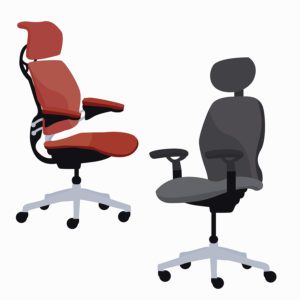Call Us Now1-800-414-2174


Ergonomics Tip
As ergonomic specialists, we have always warned office employees to avoid any computer work station set up that encourages, or forces, one to reach. The most common causes of reaching while working at computers are:
Reaching is a significant ergonomic risk factor as it increases static muscle tension in the shoulder, arm and forearm. Highly repetitive and sustained typing and mousing adds to the stress of reaching, leading to forearm muscle fatigue from chronic muscle tension. The negative impacts of sustained muscle tension are fatiguing of the muscle’s contractile fibers (e.g., depletion of the calcium channels) and compression on microscopic capillaries that reduces blood follow and the transport of oxygen. Consequently, sustained muscle tension can lead to tendonitis (e.g., tennis elbow) and/or median nerve compression syndrome in the carpal tunnel from inflamed, swollen flexor tendons (Bunch and Bardarson, 2017).
In cases where a person is sitting slumped and leaning forward while reaching, impingement can occur in the shoulder leading to, over time, subacromial bursitis and/or rotator cuff tendonitis. Also, when a person uses arm rests for arm support while typing there is an increased risk that the person will lean down on the arm rests and plant the forearms. This behavior not only increases the risk associated with contact stress on the elbow, but also like planting the wrist, increases the extension posture of the wrist which creates biomechanical stress on forearm muscles that extend the wrist and fingers (Bunch and Bardarson, 2017)
Fundamentally, the keyboard and mouse/input device should be positioned directly in front of the person in such proximity that the person can both type/input data and mouse without any significant shoulder flexion (i.e., without reaching from the shoulder). A relatively common reason the keyboard and mouse may not be maintained in such close proximity to the user is the poor work habit of making space on the desk top in front of the keyboard for writing (thereby moving the keyboard and the mouse further away from the seated user).
Although Trevor and I have historically addressed this issue from our clinical experience and training in biomechanics, a recent study by Grey (2016) has provided objective physiological measurements of the risks associated with poorly positioned keyboards and using arm rests while typing or inputting data. In this study, Grey analyzed effects of computer use on baseline muscle tension (BMT). The results of Grey’s study objectively revealed that:
Grey’s study examined the two paradigms by setting up various work station situations and then by positioning ergonomic gyroscopic sensors on the subjects as they performed a variety of tasks. The sensor used was a combination type Cricket muscle / posture sensor (sEMG + gyroscope) which added quantitative data to validate ergonomic evaluations and adjustments.
When evaluating which posture/setup was less strenuous and, therefore, more ergonomically correct, the article analyzed baseline muscle tension (BMT). The results were that typing with armrests resulted in a baseline muscle tension of 6.5 vs. 3.4 when typing without armrests (the article postulated that this was because subjects would “slump” and place force on their body when resting on armrests). The BMT results for a keyboard that was positioned far from the user was 11.6 vs. 3.5 for a close keyboard where the user can keep their arms at a 90 degree angle while typing.
In general, Trevor and I feel that there is very seldom any advantage to having arm rests on chairs. Besides the Grey study suggesting that people use arm rests to slump or lean on (which we concur with from our own ergonomic consulting experiences), arm rests often interfere with a person’s ability to properly sit close enough to the keyboard to avoid reaching. Likewise, we do not see any value in using wrist gel cushions for either a mouse pad or keyboard. Such gel pads further promote planting of the wrist, increasing the level of BMT and associated problems. Lastly, office employees must try to avoid moving the keyboard and mouse away from them in order to use desk space as a writing surface. A separate area should be designated for writing. Computer space should always remain computer space.
If you have any questions about office or field ergonomics, please feel free to call WorkSaver at (800) 414-2174 and ask for Dr. Bunch or Trevor Bardarson. If interested in becoming a Certified Behavioral-based Ergonomics Specialist, please visit our ergonomics training web site: www.CBES-Ergonomics.com.
References:
Bunch, R., Bardarson, T., Certified Behavioral Based Ergonomics Specialist (CBES) Certification Program, 2017
Grey, A., Investigating Ergonomic Heuristic Paradigms Quantitatively with Cricket Muscle Sensors. Somaxis Inc., 2016.
WorkSaver Employee Testing Systems 478 Corporate Dr. Houma, LA 70360
![]()